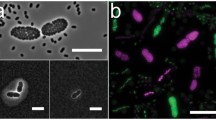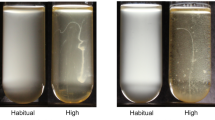Abstract
Across many phyla, a common aspect of multicellularity is the organization of different cell types into spatial patterns. In the budding yeast Saccharomyces cerevisiae, after diploid colonies have completed growth, they differentiate to form alternating layers of sporulating cells and feeder cells. In the current study, we found that as yeast colonies developed, the feeder cell layer was initially separated from the sporulating cell layer. Furthermore, the spatial pattern of sporulation in colonies depended on the colony’s nutrient environment; in two environments in which overall colony sporulation efficiency was very similar, the pattern of feeder and sporulating cells within the colony was very different. As noted previously, under moderately suboptimal conditions for sporulation—low acetate concentration or high temperature—the number of feeder cells increases as does the dependence of sporulation on the feeder-cell transcription factor, Rlm1. Here we report that even under a condition that is completely blocked sporulation, the number of feeder cells still increased. These results suggest broader implications to our recently proposed “Differential Partitioning provides Environmental Buffering” or DPEB hypothesis.



Similar content being viewed by others
References
Ables ET, Laws KM, Drummond-Barbosa D (2012) Control of adult stem cells in vivo by a dynamic physiological environment: diet-dependent systemic factors in Drosophila and beyond. Wiley Interdiscip Rev Dev Biol 1(5):657–674. doi:10.1002/wdev.48
Albuquerque P, Casadevall A (2012) Quorum sensing in fungi—a review. Med Mycol 50(4):337–345. doi:10.3109/13693786.2011.652201
Baroiller JF, D’Cotta H, Saillant E (2009) Environmental effects on fish sex determination and differentiation. Sex Dev 3(2–3):118–135. doi:10.1159/000223077
Blank LM, Sauer U (2004) TCA cycle activity in Saccharomyces cerevisiae is a function of the environmentally determined specific growth and glucose uptake rates. Microbiology 150(Pt 4):1085–1093. doi:10.1099/mic.0.26845-0
Brakefield PM, Gems D, Cowen T, Christensen K, Grubeck-Loebenstein B, Keller L, Westendorp RG (2005) What are the effects of maternal and pre-adult environments on ageing in humans, and are there lessons from animal models? Mech Ageing Dev 126(3):431–438. doi:10.1016/j.mad.2004.07.013
Cap M, Stepanek L, Harant K, Vachova L, Palkova Z (2012) Cell differentiation within a yeast colony: metabolic and regulatory parallels with a tumor-affected organism. Mol Cell 46(4):436–448. doi:10.1016/j.molcel.2012.04.001
Cortassa S, Aon JC, Aon MA, Spencer JF (2000) Dynamics of metabolism and its interactions with gene expression during sporulation in Saccharomyces cerevisiae. Adv Microb Physiol 43:75–115. http://www.ncbi.nlm.nih.gov/entrez/query.fcgi?cmd=Retrieve&db=PubMed&dopt=Citation&list_uids=10907555
Cullen PJ (2015) Evaluating yeast filamentous growth at the single-cell level. Cold Spring Harb Protoc 2015(3):272–275. doi:10.1101/pdb.prot085084
Danielsen ET, Moeller ME, Rewitz KF (2013) Nutrient signaling and developmental timing of maturation. Curr Top Dev Biol 105:37–67. doi:10.1016/B978-0-12-396968-2.00002-6
Eggert C (2004) Sex determination: the amphibian models. Reprod Nutr Dev 44(6): 539–549. http://www.ncbi.nlm.nih.gov/pubmed/15762298
Gagiano M, Bauer FF, Pretorius IS (2002) The sensing of nutritional status and the relationship to filamentous growth in Saccharomyces cerevisiae. FEMS Yeast Res 2(4):433–470
Gordon DM (2013) The rewards of restraint in the collective regulation of foraging by harvester ant colonies. Nature 498(7452):91–93. doi:10.1038/nature12137
Honigberg SM (2011) Cell signals, cell contacts, and the organization of yeast communities. Eukaryot Cell 10(4):466–473. doi:10.1128/EC.00313-10
Jambhekar A, Amon A (2008) Control of meiosis by respiration. Curr Biol 18(13):969–975. doi:10.1016/j.cub.2008.05.047
Jung US, Sobering AK, Romeo MJ, Levin DE (2002) Regulation of the yeast Rlm1 transcription factor by the Mpk1 cell wall integrity MAP kinase. Mol Microbiol 46(3): 781–789. http://www.ncbi.nlm.nih.gov/pubmed/12410835
Loomis WF (2014) Cell signaling during development of Dictyostelium. Dev Biol 391(1):1–16. doi:10.1016/j.ydbio.2014.04.001
McCusker JH, Clemons KV, Stevens DA, Davis RW (1994a) Genetic characterization of pathogenic Saccharomyces cerevisiae isolates. Genetics 136(4):1261–1269. http://www.ncbi.nlm.nih.gov/pubmed/8013903
McCusker JH, Clemons KV, Stevens DA, Davis RW (1994b) Saccharomyces cerevisiae virulence phenotype as determined with CD-1 mice is associated with the ability to grow at 42 degrees C and form pseudohyphae. Infect Immun 62(12):5447–5455. http://www.ncbi.nlm.nih.gov/pubmed/7960125
Merchant-Larios H, Diaz-Hernandez V (2013) Environmental sex determination mechanisms in reptiles. Sex Dev 7(1–3):95–103. doi:10.1159/000341936
Niklas KJ, Newman SA (2013) The origins of multicellular organisms. Evol Dev 15(1):41–52. doi:10.1111/ede.12013
Piccirillo S, Honigberg SM (2010) Sporulation patterning and invasive growth in wild and domesticated yeast colonies. Res Microbiol 161(5):390–398. doi:10.1016/j.resmic.2010.04.001
Piccirillo S, Honigberg SM (2011) Yeast colony embedding method. J Vis Exp. doi:10.3791/2510
Piccirillo S, White MG, Murphy JC, Law DJ, Honigberg SM (2010) The Rim101p/PacC pathway and alkaline pH regulate pattern formation in yeast colonies. Genetics 184(3):707–716. doi:10.1534/genetics.109.113480
Piccirillo S, Morales R, White MG, Smith K, Kapros T, Honigberg SM (2015) Cell differentiation and spatial organization in yeast colonies: role of cell-wall integrity pathway. Genetics 201(4):1427–1438. doi:10.1534/genetics.115.180919
Shapiro JA (1998) Thinking about bacterial populations as multicellular organisms. Annu Rev Microbiol 52:81–104. doi:10.1146/annurev.micro.52.1.81
Vachova L, Cap M, Palkova Z (2012) Yeast colonies: a model for studies of aging, environmental adaptation, and longevity. Oxid Med Cell Longev 2012:601836. doi:10.1155/2012/601836
Vachova L, Hatakova L, Cap M, Pokorna M, Palkova Z (2013) Rapidly developing yeast microcolonies differentiate in a similar way to aging giant colonies. Oxid Med Cell Longev 2013:102485. doi:10.1155/2013/102485
Waters CM, Bassler BL (2005) Quorum sensing: cell-to-cell communication in bacteria. Annu Rev Cell Dev Biol 21:319–346. doi:10.1146/annurev.cellbio.21.012704.131001
Wilson EO, Holldobler B (1988) Dense heterarchies and mass communication as the basis of organization in ant colonies. Trends Ecol Evol 3(3):65–68. doi:10.1016/0169-5347(88)90018-3
Acknowledgments
We are grateful for the use of the confocal microscope in the University Missouri, Kansas City School of Dentistry Confocal Microscopy Core. This facility is supported by the UMKC Office of Research Services, the UMKC Center of Excellence in Dental and Musculoskeletal Tissues, and NIH grant S10RR027668. We are grateful to Dr. David Levin (Boston University) for the UASRlm1-LacZ plasmid. We thank Mr. Benjamin Iwai for sectioning embedded colonies. Research in this publication was funded by the National Institutes of General Medical Sciences of the NIH under award number R15GM094770.
Author information
Authors and Affiliations
Corresponding author
Additional information
Communicated by M. Kupiec.
Rights and permissions
About this article
Cite this article
Piccirillo, S., Kapros, T. & Honigberg, S.M. Phenotypic plasticity within yeast colonies: differential partitioning of cell fates. Curr Genet 62, 467–473 (2016). https://doi.org/10.1007/s00294-015-0558-y
Received:
Revised:
Accepted:
Published:
Issue Date:
DOI: https://doi.org/10.1007/s00294-015-0558-y




